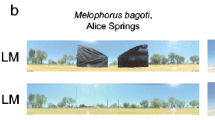Abstract
Foraging desert ants, Cataglyphis fortis, monitor their position relative to the nest by path integration. They continually update the direction and distance to the nest by employing a celestial compass and an odometer. In the present account we addressed the question of how the precision of the ant’s estimate of its homing distance depends on the distance travelled. We trained ants to forage at different distances in linear channels comprising a nest entrance and a feeder. For testing we caught ants at the feeder and released them in a parallel channel. The results show that ants tend to underestimate their distances travelled. This underestimation is the more pronounced, the larger the foraging distance gets. The quantitative relationship between training distance and the ant’s estimate of this distance can be described by a logarithmic and an exponential model. The ant’s odometric undershooting could be adaptive during natural foraging trips insofar as it leads the homing ant to concentrate the major part of its nest-search behaviour on the base of its individual foraging sector, i.e. on its familiar landmark corridor.



Similar content being viewed by others
References
Anderson DR, Burnham KP, Thompson WL (2000) Null hypothesis testing: problems, prevalence, and an alternative. J Wildl Manage 64:912–923
Burnham KP, Anderson DR (2001) Kullback-Leibler information as a basis for strong inference in ecological studies. Wildl Res 28:111–119
Burnham KP, Anderson DR (2002) Model selection and multimodel inference: a practical information-theoretic approach, 2nd edn. Springer, Berlin Heidelberg New York
Cheng K, Srinivasan MV, Zhang SW (1999) Error is proportional to distance measured by honeybees: Weber’s law in the odometer. Anim Cogn 2:11–16
Chittka L, Williams NM, Rasmussen H, Thomson JD (1999) Navigation without vision: bumblebee orientation in complete darkness. Proc R Soc Lond Ser B 266:45–50
Esch HE, Burns JE (1995) Honeybees use optic flow to measure the distance of a food source. Naturwissenschaften 82:38–40
Esch HE, Zhang SW, Srinivasan MV, Tautz J (2001) Honeybee dances communicate distances measured by optic flow. Nature 411:581–583
Fechner GT (1860) Elemente der Psychophysik. Breitkopf und Härtel, Leipzig
Frisch K von (1965) Tanzsprache und Orientierung der Bienen. Springer, Berlin Heidelberg New York
Frisch K von, Kratky O (1962) Über die Beziehung zwischen Flugweite und Tanztempo bei der Entfernungsmeldung der Bienen. Naturwissenschaften 49:409–417
Hartmann G, Wehner R (1995) The ant’s path integration system: a neural architecture. Biol Cybern 73:483–497
Heusser D, Wehner R (2002) The visual centring response in desert ants, Cataglyphis fortis. J Exp Biol 205:585–590
Mittelstaedt H (1983) The role of multimodel convergence in homing by path integration. In: Horn E (ed) Multimodel convergences in sensory systems. Fortschritte der Zoologie, vol 28. Fischer, Stuttgart, pp 197–212
Müller M, Wehner R (1988) Path integration in desert ants, Cataglyphis fortis. Proc Natl Acad Sci USA 85:5287–5290
Müller M, Wehner R (1994) The hidden spiral: systematic search and path integration in desert ants, Cataglyphis fortis. J Comp Physiol A 175:525–530
Ronacher B, Wehner R (1995) Desert ants Cataglyphis fortis use self-induced optic flow to measure distances travelled. J Comp Physiol A 177:21–27
Ronacher B, Gallizzi K, Wohlgemuth S, Wehner R (2000) Lateral optic flow does not influence distance estimation in the desert ant Cataglyphis fortis. J Exp Biol 203:1113–1121
Schöne H (1996) Optokinetic speed control and estimation of travel distance in walking honeybees. J Comp Physiol A 179:587–592
Si A, Srinivasan MV, Zhang SW (2003) Honeybee navigation: properties of the visually driven ‘odometer’. J Exp Biol 206:1265–1273
Sokal RR, Rohlf FJ (1998) Biometry, 3rd edn. Freeman, New York
Srinivasan MV, Zhang SW, Lehrer M, Collett TS (1996) Honeybee navigation en route to the goal: visual flight control and odometry. J Exp Biol 199:237–244
Srinivasan MV, Zhang SW, Bidwell NJ (1997) Visually mediated odometry in honeybees. J Exp Biol 200:2513–2522
Srinivasan MV, Zhang SW, Altwein M, Tautz J (2000) Honeybee navigation: nature and calibration of the “odometer”. Science 287:851–853
Stevens SS (1957) On the psychophysical law. Psychol Rev 64:153–181
Visscher KP, Seeley TD (1982) Foraging strategy of honeybee colonies in a temperate deciduous forest. Ecology 63:1790–1801
Wehner R (1987) Spatial organization of foraging behavior in individually searching desert ants, Cataglyphis (Sahara desert) and Ocymyrmex (Namib desert). In: Pasteels JM, Deneubourg J-L (eds) From individual to collective behavior in social insects. Birkhäuser, Basel, pp 15–42
Wehner R (1992) Arthropods. In: Papi F (ed) Animal homing. Chapman and Hall, London, pp 45–144
Wehner R (2003) Desert ant navigation: how miniature brains solve complex tasks. J Comp Physiol A 189:579–588
Wehner R, Srinivasan MV (1981) Searching behaviour of desert ants, genus Cataglyphis (Formicidae, Hymenoptera). J Comp Physiol A 142:315–338
Wehner R, Michel B, Antonsen P (1996) Visual navigation in insects: coupling of egocentric and geocentric information. J Exp Biol 199:129–140
Wohlgemuth S, Ronacher B, Wehner R (2001) Ant odometry in the third dimension. Nature 411:795–798
Wohlgemuth S, Ronacher B, Wehner R (2002) Distance estimation in the third dimension in desert ants. J Comp Physiol A 188:273–281
Zollikofer CPE (1988) Vergleichende Untersuchungen zum Laufverhalten von Ameisen (Hymenoptera: Formicidae). PhD thesis, University of Zürich
Acknowledgements
We thank Robyn Tourle for help in the field experiments and Dr Larry Abbott for helpful comments on an earlier version of the manuscript. Financial support came from the Swiss National Science Foundation (grant no. 31–61844.00) and the G. and A. Claraz Foundation.
Author information
Authors and Affiliations
Corresponding author
Rights and permissions
About this article
Cite this article
Sommer, S., Wehner, R. The ant’s estimation of distance travelled: experiments with desert ants, Cataglyphis fortis . J Comp Physiol A 190, 1–6 (2004). https://doi.org/10.1007/s00359-003-0465-4
Received:
Revised:
Accepted:
Published:
Issue Date:
DOI: https://doi.org/10.1007/s00359-003-0465-4




